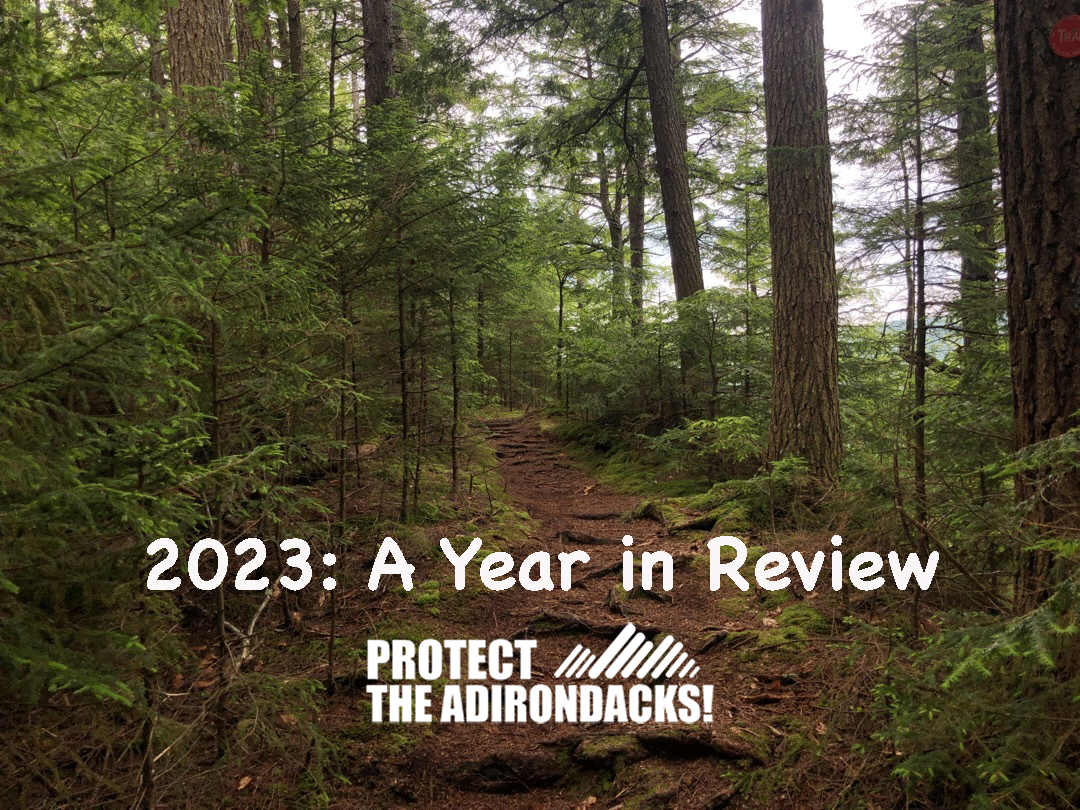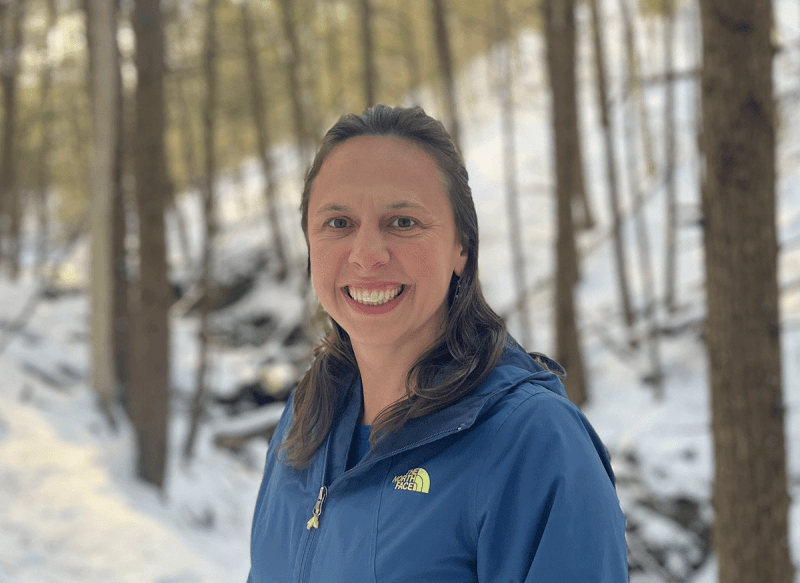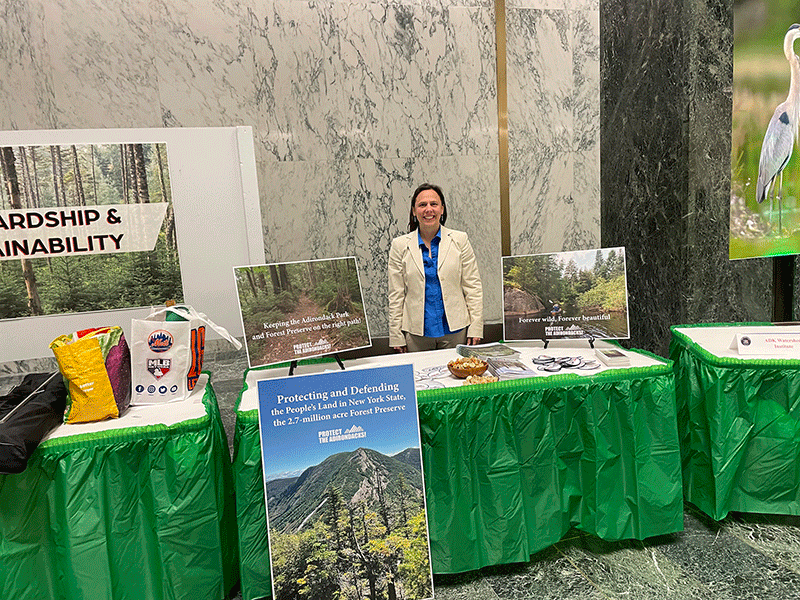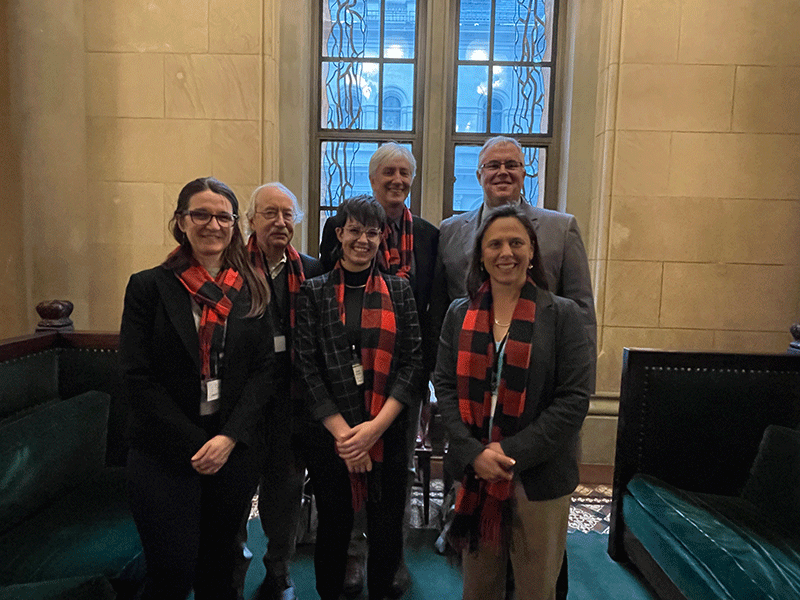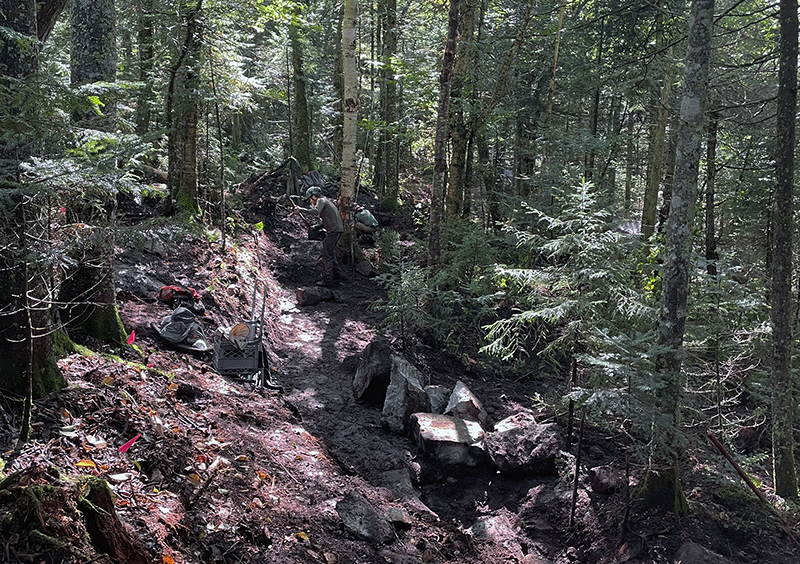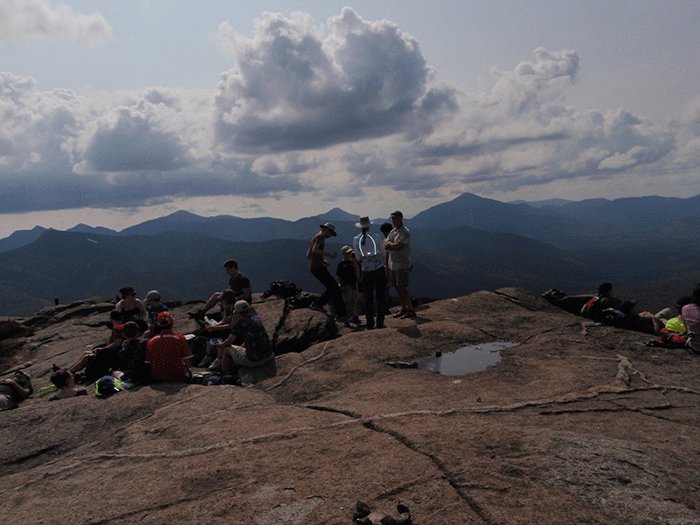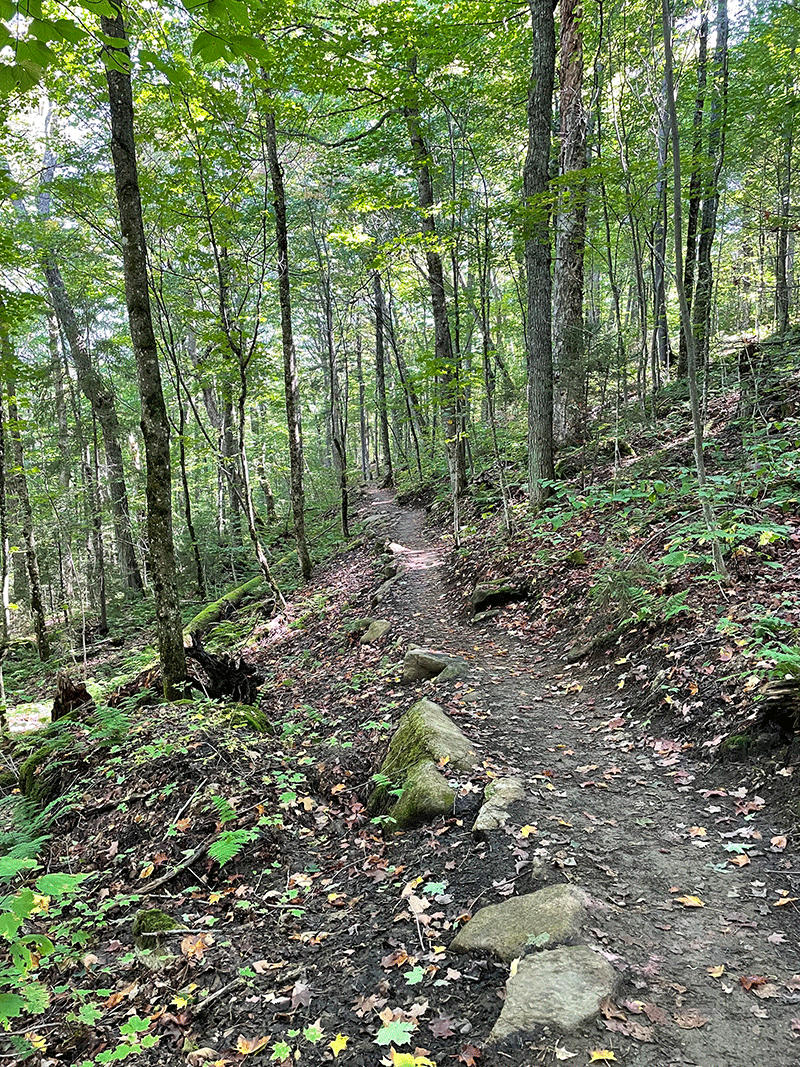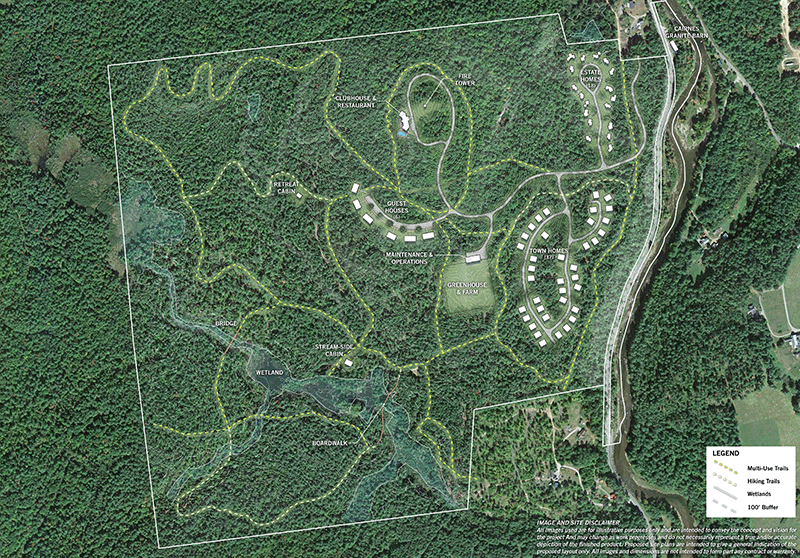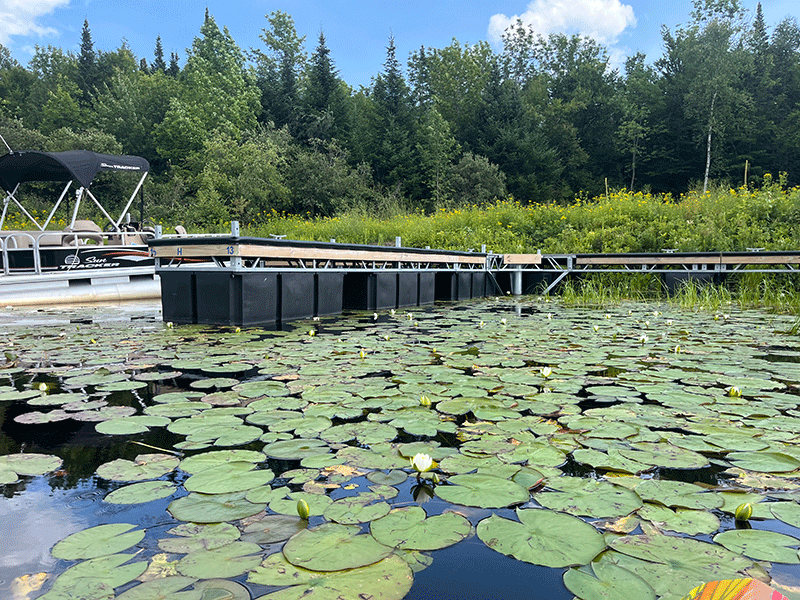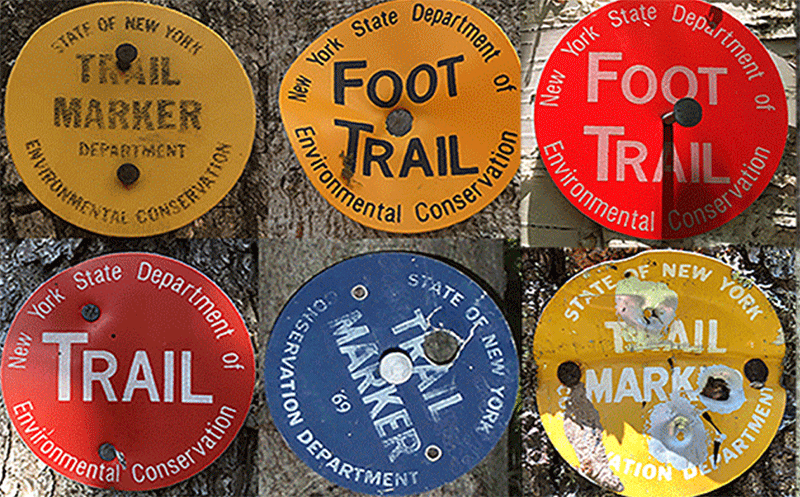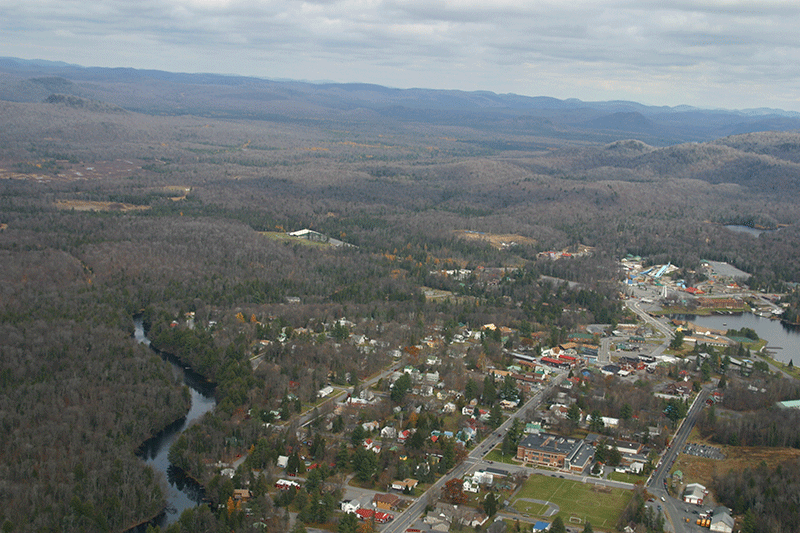In our work to uphold the Forever Wild protections for the Forest Preserve and protect the wild places and rural communities of the Adirondack Park, 2023 saw some major gains, incremental gains, and set the stage for future gains. Each year, Protect the Adirondacks implements an agenda through advocacy, independent public oversight, research, legal action, grassroots organizing, and public education that enhances protections for the natural resources of the Adirondack Park and helps to build viable communities.
PROTECT Hired Claudia Braymer as its New Deputy Director in 2023 as Part of Staff Leadership Succession Planning
Claudia Braymer started as the new Deputy Director in early 2023. Claudia brings extensive experience as a long-time practicing environmental attorney in Glens Falls where she served as co-Counsel in PROTECT’s 10-year-long Forever Wild lawsuit. She was an elected At-Large Supervisor from Glens Falls on the Warren County Board of Supervisors for four terms. Claudia and her husband and two children have hiked and camped widely throughout the Adirondacks. Claudia’s hiring is part of PROTECT’s staffing succession plan as the current executive director Peter Bauer changes his role in the organization and eventually retires. Claudia will take over as the new Executive Director in the coming year. Claudia and John Caffry were honored with PROTECT’s highest award, the Howard Zahniser Adirondack Award, in 2021.
Advocacy
In 2023, Protect the Adirondacks advocated for various New York State budget items to support and improve management of the public Forest Preserve and support vital Adirondack Park institutions. We submitted budget testimony to the Legislature. We worked with other groups to host the Adirondack Park Environmental Lobby Day, where volunteers and activists talked to scores of Legislators and staff with the message of investing in the protection of the Adirondack Park. PROTECT helped to advocate for state spending on the Forest Preserve in the Environmental Protection Fund, for municipal water and sewer upgrade funding, more state Forest Rangers, support for the Timbuctoo Summer Climate and Career Institute the Survey of Climate Change and Adirondack Lakes Ecosystems (SCALE) study. We advocated for support for the Paul Smith’s College Adirondack Watershed Institute, Adirondack Experience, SUNY ESF Newcomb Visitors Interpretive Center, the Paul Smith’s College Visitors Interpretive Center, and the Adirondack Diversity Initiative.
We also were in Albany for the Environmental Protection Fund Lobby Day 2023, to advocate for funding of $400 million for projects that support land acquisition, State and municipal land stewardship, and invasive species prevention. Each year, PROTECT advocates for the EPF to be funded at the highest possible level in the State budget so that funding can be made available for open space and farmland protection programs, invasive species control, Adirondack wilderness protection and visitor safety, the, among other critical programs. The annual Adirondack Day in Albany is also an opportunity to push for various legislative priorities.
On the legislative front, our work was successful in working with a statewide coalition to pass a new law to prohibit wildlife killing contests, which had languished for 20 years in the Legislature before passing the Assembly and Senate and being signed into law by Governor Hochul. We also lobbied for the legislation in support for wildlife travel corridors safety and wildlife overpasses. The Biden Administration has made $350 million dollars available for wildlife crossings through the bipartisan Infrastructure Law and this legislation would direct state agencies to identify sites where wildlife crossings are needed most to increase public safety and improve habitat connectivity. This bill passed the Senate in 2023, but did not make it in the Assembly.
Protect the Adirondacks also focused on three constitutional amendments in 2023 to Article 14, Section 1, the Forever Wild clause. After many years of work, an amendment that we supported was passed to retroactively authorize facilities, including trails, buildings, water lines and parking lots, on 323 acres of Forest Preserve lands that are part of the 1,220-acre Mt. Van Hoevenberg Winter Sports Complex near Lake Placid. This amendment is needed to bring this facility into compliance with the Forever Wild clause. The amendment received “First Passage” from both houses of the Legislature in 2023 and will need “Second Passage” in 2025 before it can be submitted for a statewide referendum.
PROTECT supported the proposed amendment to sell 92 acres of the former Camp Gabriels prison compound in Franklin County, but while this bill passed the Senate it was stalled in the State Assembly. Going forward, two other state prisons, Moriah Shock in Moriah and Mount McGregor in Saratoga County, have been disbanded by the state. Like Camp Gabriels, these prisons sit on Forest Preserve lands and the first step for the state to repurpose them is to remove them from the Forest Preserve through a constitutional amendment. We think an amendment that deals with all three facilities makes sense.
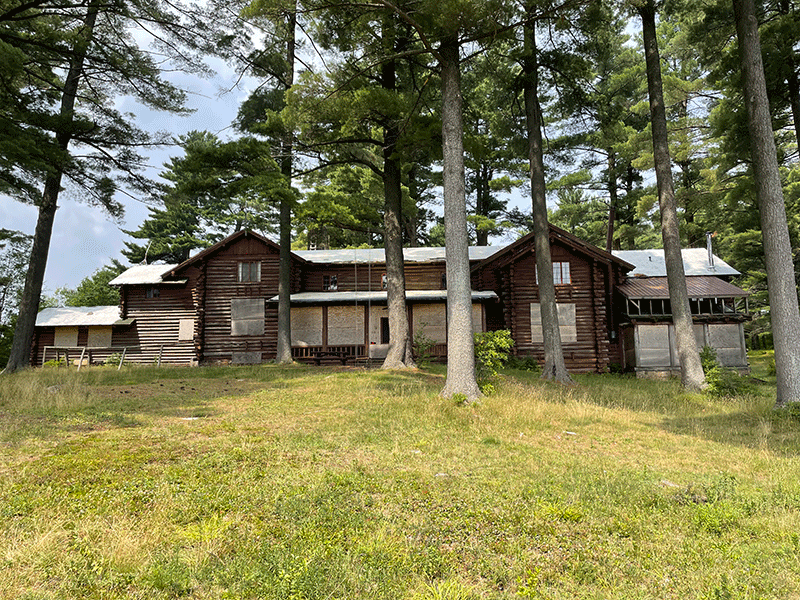
Debar Lodge and the various outbuildings around should be torn down so that the area could be a wild area, yet highly accessible, for swimming, fishing, paddling and picnicking.
PROTECT opposed an amendment to privatize six acres of Forest Preserve lands on the north shore of Debar Pond for a transfer to a private institution. These lands are currently owned by the People of the State of New York, and have significant open space, natural resource, and public recreational value because they provide unfettered public access to one of the most remote and scenic water bodies in the Adirondack Park. PROTECT supports keeping this land in the Forest Preserve so that visitors can enjoy a wild lake experience similar to Lake Lila in the William C. Whitney Wilderness Area. This proposed constitutional amendment is a bad deal for New Yorkers and for the Forest Preserve. Please sign our petition to help block this amendment and help us to save Debar Pond.
PROTECT also pushed for the release of the Adirondack Road Salt Reduction Task Force final report, which had been jammed up by state agencies until its release in the fall of 2023. The report makes clear that the science is not disputed about road salt pollution and relies heavily on Adirondack Lake Assessment Program data, a core PROTECT project for more than 25 years. The State’s follow-up has yet to be determined, but efforts are looking at some kind of oversight council. This may be a step in the right direction, but the devil is in the details. PROTECT is also exploring legal options so that road salt use is regulated and reduced.
Independent Public Oversight
Throughout 2023, PROTECT monitored and intervened in the regulatory and management process over the Forest Preserve and private lands of the Adirondack Park. We actively monitored the alphabet soup of state and local agencies, watch-dogging the work of the Adirondack Park Agency (APA), Department of Environmental Conservation (DEC), Olympic Regional Development Authority (ORDA), Department of Transportation (DOT), and the dozens of local town, village, and county governments. After researching and reviewing materials, PROTECT often submitted written comments, which are all posted under Public Comments on our website. We submitted more than three dozen comment letters in 2023, stressing that state agencies should always comply with and uphold the law.
On Forest Preserve management, 2023 saw some modest steps at reform by state agencies. PROTECT’s win in the Forever Wild lawsuit in 2021 has pushed the DEC and APA to improve their management, though much more needs to be done. Unfortunately, positive steps in one area were matched by corresponding negative actions in others, the yin and yang of state agencies adrift without coherent leadership as both agencies continue using Forest Preserve management as bargaining chips for their political objectives.
In 2023, PROTECT’s independent public oversight included our participation on three advisory committees, including the Forest Preserve Trails Stewardship Working Group, High Peaks Regional Advisory Committee for Visitor Use Management, and the Forest Preserve Advisory Committee. These bodies provide an opportunity to get information on policy issues and provide feedback with a diverse array of other stakeholders.
2023 saw the first meaningful product from the Forest Preserve Trails Stewardship Working Group as it worked to help develop a new DEC Commissioners Policy on “Forest Preserve Work Plans,” now known as CP-78. Works Plans are developed for management activities, such as trail work, bridge construction, campsite and parking lot construction, among other things. PROTECT had pushed for changes to the Work Plan process.
The new Forest Preserve Work Plan guidance marks a significant departure from past practice by limiting tree cutting, changes to the terrain, and the overall impacts to natural resources during management activities. A new public review process was also added to ensure transparency and public accountability. These changes were enshrined in a new DEC Commissioner’s Policy (CP-78) for Forest Preserve Work Plans. Draft Work Plans are now provided for public comment and all final plans are posted on the DEC’s website.
Unfortunately, CP-78 incorporates only three of the six Article 14 criteria set forth in Forest Preserve case law, which could lead to problems down the road. Omitted issues include prohibitions on overly wide trails, a directive to limit impacts of a project on the Forest Preserve to the lightest possible, as seen with hiking and camping, and the directive that the principal purpose of the Forest Preserve is the preservation of Wilderness.
A key failure in the implementation of the new Work Plan template and process is that DEC is conducting its Forest Preserve constitutional compliance assessment behind closed doors, out of sight, shrouded in secrecy. DEC refuses to provide any discussion or summary of how and why a given project complies with the Forever Wild clause. One would think that an agency that had just been found by the state’s highest court to have violated the State Constitution would do everything possible to show the world that it is in full compliance with the Forever Wild clause. Unfortunately, it appears that the DEC is doing the opposite, choosing to embrace secrecy and opacity. The DEC is saying it has a process to ensure Constitutional compliance without any accountability to the public that it has done the work.
2023 also saw new use of Visitor Use Management (VUM) planning for the central High Peaks Wilderness in the Adirondacks and the Kaaterskill Falls area in the Catskills. VUM was developed by the National Park Service and has been widely implemented at many National Parks and National Forests. VUM is a wilderness management methodology that balances visitor use in a wild, natural area while protecting the natural resources and the quality and character of visitor experiences. Use of VUM has long been advocated by PROTECT and the Adirondack environmental community, and was a central recommendation by the High Peaks Regional Advisory Committee. The DEC contracted with a national firm to develop a pilot VUM plan for the central High Peaks.
We pushed unsuccessfully for the completion of long required, yet never completed, Carrying Capacity studies on Adirondack lakes. We focused on the Saranac Lake Chain because of marina expansions, large state campgrounds and boat launches, and extensive developments and boat-access-only properties and campsites. We urged the DEC to fulfil its obligation pursuant to the Adirondack Park State Land Master Plan and the Unit Management Plan (UMP) for the Saranac Lake Wild Forest (SLWF) by completing a carrying capacity study for water bodies in the SLWF. The study is necessary to evaluate the environmental and social impacts of visitor overuse of these water bodies and is particularly crucial in light of the APA’s recent approval of a major commercial marina expansion on Lower Saranac Lake and a pending application for expansion of another commercial marina on Upper Saranac Lake.
We continued to monitor the performance of the new sustainable trail up Mt. Van Hoevenberg. The trail starts at the new Visitor Center at the Mt. Van Hoevenberg Winter Sports Complex and runs 2.5 miles up the northeast flanks of the mountain. The trail took nearly five years to finish but was the first completely constructed sustainable trail in the Forest Preserve. The trail was labor intensive, as trail crews used only hand tools in the long sections in the High Peaks Wilderness Area, though the trail was constructed with machinery where it runs through private lands and Intensive Use areas at the Winter Sports Complex. The trail is anticipated to need minimal maintenance in the years ahead.
The State is now in the third year of work on the new Cascade Mountain Trail that will run four miles from the Visitors Center at the Winter Sports Complex to the summits of Cascade and Porter mountains. This trail is also sustainably designed. While it will follow a longer route to reach the summit of Cascade Mountain, it will be easier for hikers to walk on a trail with an even trail tread, gradual elevation gain, and intact corridor. This trail is expected to open in 2025.
After we investigated reports of what was believed to be a wolf killed in New York, we spent nearly a year puzzling through a DEC cover-up to piece together the real story. In the end, the state was forced to confirm that an animal shot by a coyote hunter in central New York was indeed a wild wolf that had traveled from the Great Lakes. We helped organize independent DNA testing and worked through Freedom of Information requests to get at the truth about the animal as the DEC withheld information and lied to the public about the incident. This episode showed that New York State needs new legislation to protect wolves in the state.
In 2023, we rode herd on two major development projects. The first is a proposal for a major subdivision in the Town of Jay that as proposed will be comprised of 120 lots that will include up to 20 townhomes, each 1,800 square feet in size; up to 60 villas, each 3,500 square feet in size; up to 18 estates, each 6,500 square feet in size; up to 6 mansions, each 10,000 square feet in size; and a hotel, restaurant and spa. The second is a major expansion of the only mountaintop mining project in the Adirondacks at Barton Mine’s operation on Ruby Mountain in North River on the edge of the Siamese Ponds Wilderness.
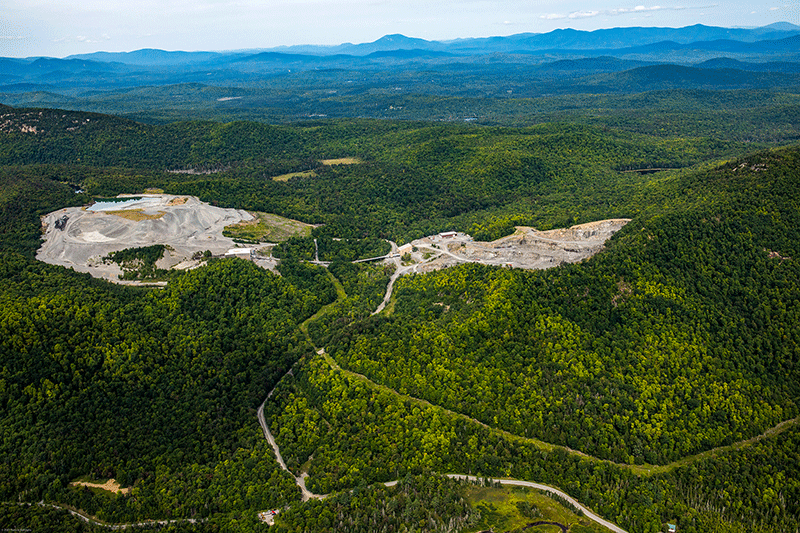
Barton Mines in Ruby Mountain. The company is seeking a major expansion and not taking into account noise, dust, and visual impacts on neighboring residents.
PROTECT continues to monitor actions by the APA and DEC to incorporate an assessment of GHG emissions for major projects as required by the Climate Leadership and Community Protection Act (CLCPA). PROTECT urged both agencies to start assessing upstream and downstream GHG emissions associated with the major subdivision proposal in Jay and the Barton Mines expansion project in Johnsburg. Despite the fact that both are major projects that will increase GHG emissions, neither DEC nor APA have yet required or performed the GHG analysis required under the CLCPA.
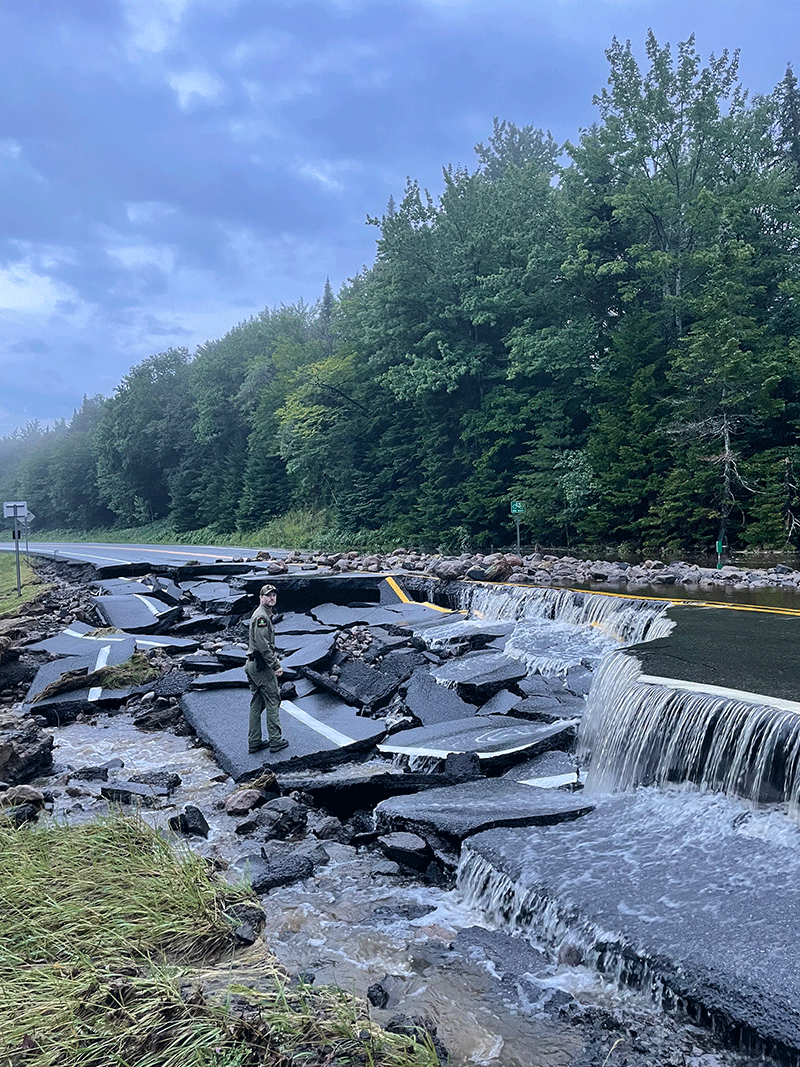
Storm and flood damage on Route 28 between Blue Mountain Lake and Long Lake, summer 2023. More severe storms, caused by our changing climate, are becoming a fact of life in the Northeast U.S.
Legal Action
Protect the Adirondacks devotes a great deal of its time and energy to advocacy and independent public oversight, but legal actions are a core part of our work. Few other organizations have invested in staff attorneys like we have. This allows us to go beyond letter or op-ed writing in our independent public oversight work so that we can challenge in court the actions that we believe are illegal and hold those in power accountable to the law and to the public.
In 2023, we were involved in four lawsuits with state agencies in efforts to uphold the Freshwater Wetlands Act, Wilderness protections, public process in review of major development projects, and the Forever Wild clause that protects the Forest Preserve in the State constitution.
In early 2023, PROTECT filed a lawsuit against the DEC challenging the department’s reconstruction of a former logging road in the High Peaks Wilderness Complex. The road had previously been reclaimed and rewilded by DEC pursuant to an approved Work Plan, which called for removing bridges and culverts and constructing a series of pits and mounds in the road corridor to recreate a natural forest landscape and accelerate forest regrowth. In the fall of 2021, DEC re-entered the road corridor and began using heavy machinery, including a bulldozer and excavator, to destroy and remove the previously constructed pits and mounds. The APA failed to undertake an enforcement action. To facilitate this work, DEC reconstructed nearly one mile of the former logging road by grading and flattening the road corridor, removing boulders, and installing a new bridge and culvert. All of this work was done in violation of the Adirondack Park State Land Master Plan, which prohibits the construction of roads in Wilderness areas for any purpose. PROTECT is waiting on a decision in this lawsuit.
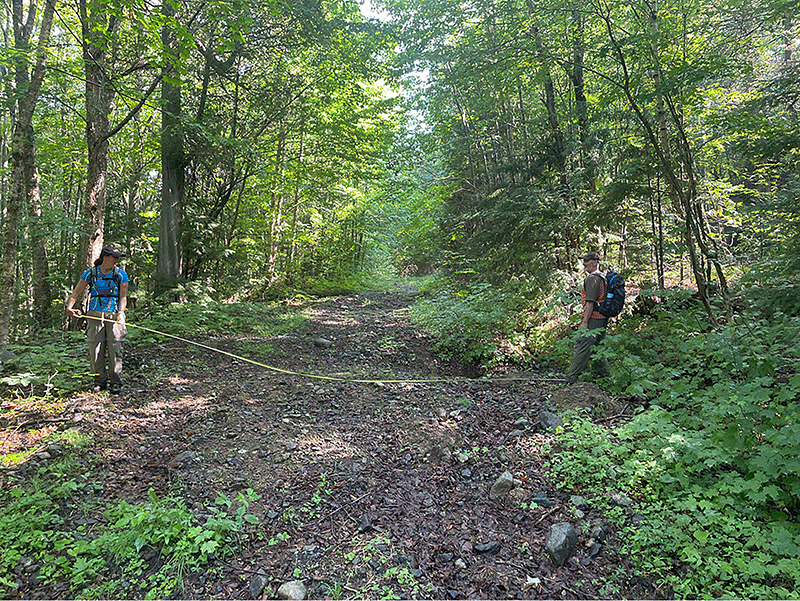
Claudia Braymer and Chris Amato take measurements of a 22-foot-wide section of regraded roadway in the High Peaks Wilderness.
In August, PROTECT filed a lawsuit against the Adirondack Park Agency (APA) challenging the APA’s approval of a major expansion of a commercial marina on Lower Saranac Lake. The proposed expansion will make the marina the largest in the Adirondack Park. Although the proposed expansion will occur in and over thousands of square feet of protected wetlands, the APA approved the project without requiring a wetland permit—reversing eight years of prior APA determinations that the proposed expansion cannot proceed without a wetland permit. The lawsuit also challenges the APA’s failure to require a variance for a multitude of new structures in the lake that do not meet the shoreline setback restrictions and challenges the APA’s granting of a variance for shoreline structures even though the applicant did not meet the regulatory criteria for a variance. PROTECT is waiting on a decision in this lawsuit.
PROTECT and its co-petitioner, the Adirondack White Lake Association, have appealed a decision from Supreme Court, Oneida County, dismissing a lawsuit challenging the APA’s approval of a major new mine in the White Lake residential community in the Town of Forestport. APA approved the project without holding an adjudicatory hearing, despite the fact that more than 3,000 comments were submitted opposing the project. In addition, the APA ignored numerous comments that identified significant deficiencies in the applicant’s evaluation of noise and water quality impacts. PROTECT is waiting on a decision in this appeal.
After a 10-year-long legal odyssey, we finally wrapped up our Forever Wild lawsuit in September 2023 when a State Supreme Court Judge in Albany County issued a final Judgment in the case against the DEC and APA. The final Judgment declared that “Defendants’ [DEC and APA] construction in the Forest Preserve of the Class II Community Connector trails that were planned and approved as of October 15, 2014, violates NY Constitution, article XIV, § 1”. The Judgment officially ends the case and orders the State to reimburse PROTECT in the amount of $32,000, which the state so far has failed to pay, for a portion of the court costs incurred during the case. Glens Falls attorney and PROTECT Board member John Caffry was the lead Counsel on the case and Claudia Braymer was co-Counsel.
PROTECT is concerned about the considerable mileage of unconstitutional Class II Community Connector trails that remain open and continue to be maintained and used for snowmobiling as if the Court of Appeals decision had never happened. It is our position that the Court of Appeals decision requires that unconstitutional Class II trails not be maintained and not remain open for snowmobiling. Unfortunately, our calls to close and restore these trails have been rebuffed by the DEC and APA. PROTECT is currently assessing whether a new lawsuit to compel closure of the unconstitutional trails is our only option.
Research
Sound information is critical to the debate over the future of the Adirondacks. Good science leads to good public policy. PROTECT is dedicated to bringing sound, reliable information that is scientifically verified to the ongoing public debate over the future of the Adirondack Park and the many challenges facing the region.
Water quality is front and center in the work of Protect the Adirondacks, a pillar of our research work. 2023 saw the successful completion of the 26th year of the Adirondack Lake Assessment Program (ALAP). ALAP is a partnership between Protect the Adirondacks and the Adirondack Watershed Institute at Paul Smith’s College. ALAP was started in 1998 with three objectives: 1) to collect long-term water quality data on individual lakes and ponds in the Adirondack Park; 2) to provide long-term trend data on individual lakes and ponds for local residents, lake associations, property owners and local governments to help organize water quality protection efforts; and 3) to assemble a profile of water quality conditions across the Adirondacks.
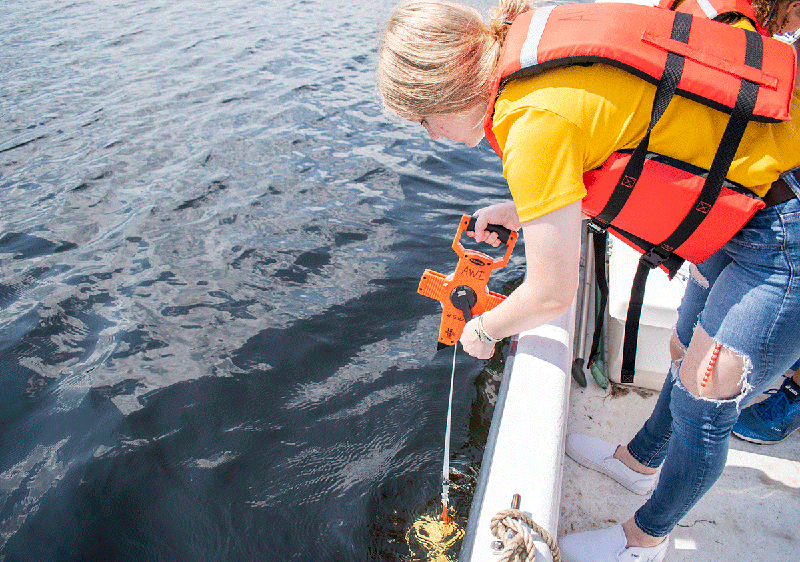
Taking a Secchi disk reading to measure water transparency. The range of transparency of Adirondack lakes is from less than 2 meters to as deep as 20 meters.
ALAP was designed as a cost-effective program based on trained volunteers and scientific analysis. ALAP has grown into one of the best citizen science programs in the Northeast U.S. ALAP data was pivotal to making the public case about reducing road salt pollution in the Adirondacks. In 2023, 78 lakes and ponds across the Adirondacks were enrolled in ALAP.
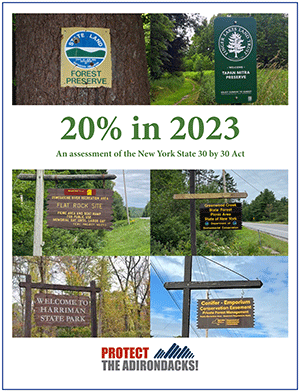 In the fall of 2023, PROTECT published 20% in 2023: An Assessment of the New York State 30 by 30 Act outlining the challenges New Yorkers face with the new “30 by 30” law that aims to protect 30% of New York’s lands and inland waters by 2030. Our research shows that we’re at 20%, with approximately 6.2 million acres of protected lands out of over 31 million acres within New York State. The Forest Preserve in the Adirondacks and Catskills make up about half of New York’s protected land base, affirming once again the importance of these lands. PROTECT is working to make sure that the State’s 30 by 30 goals are central to plans to revise the Open Space Conservation Plan. We also believe that open space conservation plays a critical role in the state’s Climate Action Plan that guides greenhouse gas emission reductions.
In the fall of 2023, PROTECT published 20% in 2023: An Assessment of the New York State 30 by 30 Act outlining the challenges New Yorkers face with the new “30 by 30” law that aims to protect 30% of New York’s lands and inland waters by 2030. Our research shows that we’re at 20%, with approximately 6.2 million acres of protected lands out of over 31 million acres within New York State. The Forest Preserve in the Adirondacks and Catskills make up about half of New York’s protected land base, affirming once again the importance of these lands. PROTECT is working to make sure that the State’s 30 by 30 goals are central to plans to revise the Open Space Conservation Plan. We also believe that open space conservation plays a critical role in the state’s Climate Action Plan that guides greenhouse gas emission reductions.
Public Education and Grassroots Organizing
Protect the Adirondacks regularly published opinion and educational articles on topical issues on our website and at the Adirondack Almanack and New York Almanack/New York History websites. We also publish op-eds, letters to the editor, guest commentaries, and post to various social media platforms like Facebook and Threads.
Our online hiking trail guides is a popular feature of our website. This guide lists 100 terrific hikes from across the Adirondack Park, and outside of the busy High Peaks Wilderness, that offer hikers great rewards that showcase the vastness and diversity of the Adirondack landscape. These hikes lead through great forests to mountains, waterfalls, bogs, and remote lakes. The online trail guides include descriptions, trail directions, pictures, and maps that detail the hike and provide information about protecting the natural resources and wild areas of the public Forest Preserve and Adirondack Park and how to be prepared for a good hike by practicing “Leave No Trace” hiking etiquette.
PROTECT regularly contacts its members to urge them attend public hearings or submit public comments or help advocate for passage of legislation. In February, we urged members to help make sure that DEC Forest Preserve Work Plans comply with the State constitution’s Forever Wild clause and are accessible and transparent. In March we asked for help to urge the APA and DEC to limit the mileage of motor vehicle roads allowed on the Forest Preserve. In April we asked for help to keep the APA open and transparent as it sought to change its public comment policy. In November we urged members to submit comments in support of a 5,800-acre Forest Preserve classification package for newly purchased lands. At a number of steps along the way, we urged members to contact legislators and the Governor to help pass Anti-Wildlife Killing contest legislation.
Protect the Adirondacks also started work to explore a regional Adirondack Park Community Housing Act, which is modeled after a similar effort on the east end of Long Island. This legislation would place a surcharge on non-resident owned properties, to create an annual fund that would be used for a variety community housing initiatives. Some type of Adirondack Housing Fund, funded by Park-wide surcharges on non-owner-occupied residential property sales and on hotel beds and short-term rentals, could generate several million dollars each year, which year-in and year-out, could help with the overall Adirondack housing challenge, in addition to what Albany and federal programs support. Such an Adirondack Housing Fund would need state legislation to authorize a tax on non-owner-occupied residential property buyers. Local and state leaders could determine how the fund is equitably administered. Many housing groups are at work across the Adirondacks, but one key limiting factor is funding to support different efforts and program. Perhaps one solution is an Adirondack Park Community Housing Act.
Throughout all of this work, the members of Protect the Adirondacks are our lifeblood. Your financial support and membership, letter and email writings, public comments at hearings, and volunteerism drives our work and builds a record of success each year for helping to keep the Adirondack Park a vital, wild, and beautiful oasis. Click here to join up as a member of Protect the Adirondacks.

